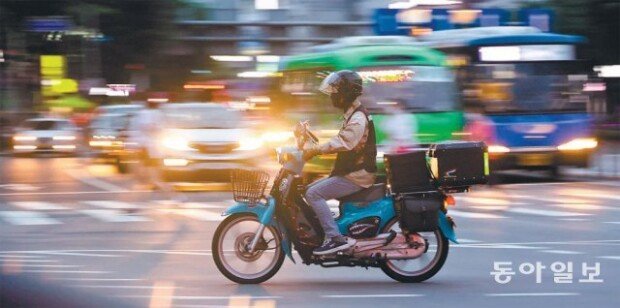South Korea never sleeps with delivery foods on their way
South Korea never sleeps with delivery foods on their way
Posted June. 29, 2021 07:22,
Updated June. 29, 2021 07:22

Amid the ongoing COVID-19 pandemic, many parts of South Korea are becoming a battlefield of deliverymen riding all day long. Last year's delivery food orders amounted to 1.31 trillion won, which exceeded the offline restaurant business' sales of 1.29 trillion won for the first time, according to Shinhan Card. Indeed, the “D-Economy,” the delivery ecosystem, is rising as one of the biggest columns of the street economy.
An owner of a noodle joint in Gwacheon, Gyeonggi Province, surnamed Kim, started delivery service as fewer people came to eat in person in the restaurant due to the COVID-19 situation. At first, he worried if people would like to get noodle dishes delivered as it can get mushy and soggy easily. However, as of now, delivery orders account for 30 percent of sales in his restaurant. "Fewer than 10 guests visited the restaurant a day. I managed to pay utilities,” said Kim. “I would not have been able to endure the situation without delivery services.
With delivery culture becoming part of everyday life, changes have been made to order regions and time ranges. The share of orders between 10 a.m. and 1 p.m. – the peak lunch time - takes up 22.6 percent, 3 percentage points up from last year's 19.5 percent, according to the country's top delivery service provider Barogo. However, the share of orders during the dinner peak time (5-8 p.m.) decreased from 45 percent in 2019 to 43.7 percent last year.
As the food delivery culture has prevailed across the nation, the number of people earning their living as deliverymen has increased accordingly. Around 220,000 platform workers accounted for 0.92 percent as of last year. The total number of such workers in the food delivery ecosystem may increase higher if it includes those working on an irregular basis on Baemin Connect, Coupang Flex, GS Woori Dongne Delivery, etc. Kim Hwa-jin, a 40-year-old factory worker, said that as he worked overtime in fewer days than before, he has started working on Coupang Flex four to five times a month. Around a quarter of workers in the food delivery market are assumed to earn around three million won. Professor Lee Byoung-hoon of Department of Sociology at Chungang University said, "With fewer jobs available in the market, many people have joined new industries such as food delivery. It serves as a new job market.”
What matters more to delivery consumers is how quickly food arrives than how tasty food is. "Fast” was the most oft-used keywords regarding delivery across social networks last year, which frequency of use increased by 48.2 percent this year, according to VAIV. By contrast, "tasty” showed a lower increase rate of frequency of use (38.8 percent). Professor Kim Ik-sung of Department of Business at Dongduk Women's University analyzed that as dawn delivery – an unprecedented service type in the world – produced a learning effect, making quickness a universal competitive edge.
Experts expect delivery service providers to engage in a growing competition over speed as they have provided customers with convenient experiences while vying to deliver food as soon as possible following the COVID-19 outbreak. Professor Seo Yong-gu of Department of Business at Sookmyung Women’s University projected that novel non-face-to-face consumer markets such as e-commerce, live commerce and D2C (Direct to Consumer) will be directed toward the new normal of "quick commerce.”
Headline News
- Joint investigation headquarters asks Yoon to appear at the investigation office
- KDIC colonel: Cable ties and hoods to control NEC staff were prepared
- Results of real estate development diverged by accessibility to Gangnam
- New budget proposal reflecting Trump’s demand rejected
- Son Heung-min scores winning corner kick







